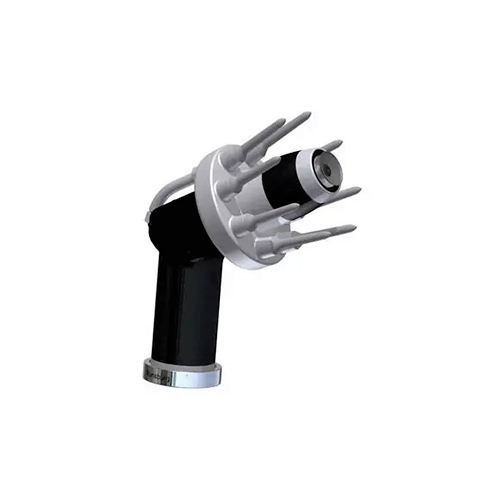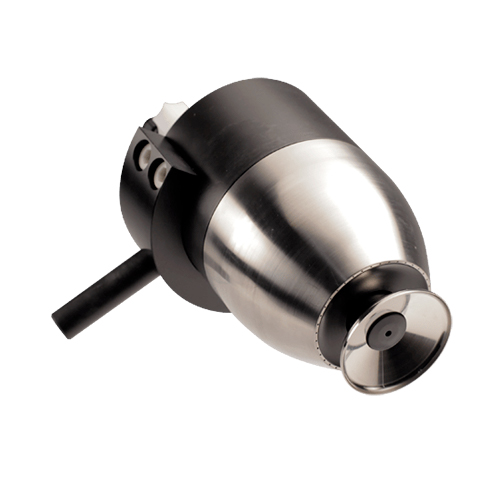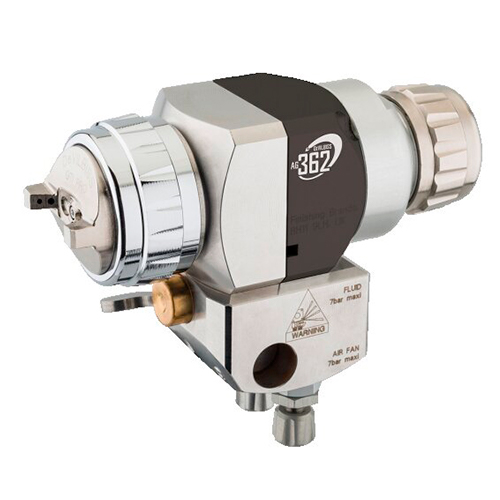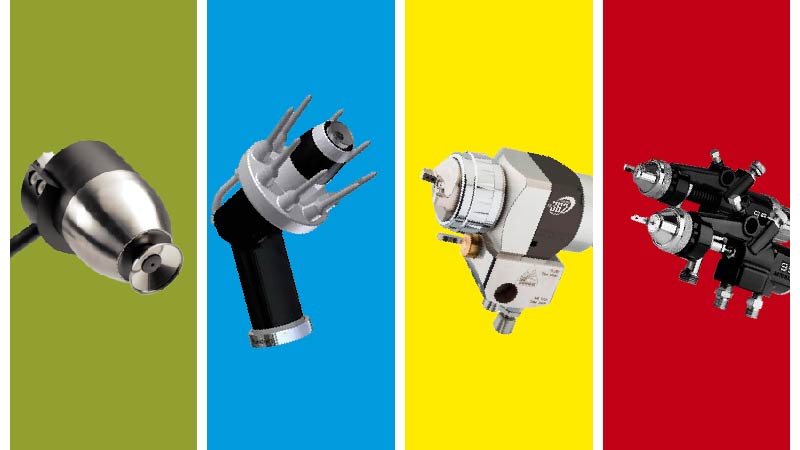Automatic spray guns are critical tools that allow industrial finishing lines to apply paint and other coatings with consistency, speed, precision, efficiency, and safety.
This article will explore the various types of automatic spray guns, their key components and features, how they work, main application, and recommendations for selecting and implementing automatic spray gun solutions for industrial finishing.
Whether you are new to automatic spray guns or you are looking to upgrade your existing equipment, this article is a valuable resource.
What are automatic spray guns?
Automatic spray guns are critical components enabling automated, high-efficiency and quality paint application in modern industrial finishing. Their programmable operation integrates seamlessly into robotic paint systems. Some key features are:
- They are electronically controlled and operate without human intervention. Settings and triggering are managed automatically
- They receive pressurized paint supply from pumps and automatically maintain optimal atomization
- Programmable controllers operate their mechanical movements and adjustments during spraying
- They are precisely engineered for consistent paint delivery and overspray control
- Automatic spray guns mount onto robotic arm endpoints or automated linear/rotary applicator systems
- Sensors provide feedback to automatically adjust spray patterns and flows
- They facilitate fast color changes by flushing paint lines and changing settings automatically
- Some feature integrated vision systems to adapt spraying based on scanned part geometries
- They help optimize paint usage by applying coatings efficiently and with minimal waste
- Automated cleaning and maintenance routines are implemented to sustain performance
- They optimize spray consistency and enable high-quality finishes unattainable manually.

The advantages of automatic spray guns
Automatic spray guns are essential tools for industrial finishing applications. They offer several advantages over manual spray guns, including:
Consistency: Automated spray parameters and positioning remove human variability from the process. They provide consistent and repeatable results, regardless of the operator. This is important for ensuring high-quality finishes, especially in long production lines.
Speed: Robotic spray systems with automatic guns maximize production speed and throughput. They can apply coatings much faster than manual spray guns. This can lead to significant productivity gains.
Precision: Since robots can be programmed to do the same task over and over again, automatic spray guns will do exactly what you have defined them to do. They can precisely control the amount of coating that is applied.
Efficiency: Automatic spray guns use less material than manual spray guns. They minimize paint waste by optimizing application paths, flow rates and overspray, which can save money on coating costs. Also, they do not take time off, which allows production to run without interruptions.
Safety: Finally, automatic spray guns can reduce operator exposure to hazardous coatings. This is especially important when the coating applied is epoxies or adhesives.
Why are automatic spray guns needed for industrial finishing?
There are several key reasons why automatic spray guns are important for industrial finishing:
Accuracy: Precision programmable controls allow automated guns to achieve coatings with tight thickness tolerances and flawless quality.
Flexibility: Automatic guns can be programmed for frequent color and pattern changes needed for variable production runs.
Ergonomics: Automated spraying reduces fatigue and injury risk associated with manual spray painting.
Superior finishes: Automatic spray control allows finishes with smoothness, gloss and durability hard to match with manual methods.
Hazard avoidance: Removing workers from the paint area improves health and safety when using hazardous solvent-based coatings.
Integrated automation: Automatic guns facilitate integration of painting into broader manufacturing automation, improving workflow.
Evidently, for a high-volume, high-quality industrial finishing production line to work flawlessly, automation is the key, providing consistency, efficiency and worker safety.
Not all automatic spray guns are the same
The needs of the particular coating application guide the selection of the ideal automatic spray gun design for industrial robotic painting. Some of the main types of automatic spray guns used in industrial applications include:
Air Spray Guns: Use compressed air to atomize paint into a fine spray pattern. Provide the highest quality finishes but overspray can be high. Common types are conventional, HVLP (high volume, low pressure), and LVLP (low volume, low pressure).
Airless Spray Guns: Fluid pressure from paint pumps atomizes the paint. Provide high paint flow rates with less overspray than air spray. Better for high production throughput.
Air-Assisted Airless Guns: Use compressed air to shape the fan pattern of atomized paint from an airless tip. Reduces overspray. It is a variant of the airless spray guns.
Electrostatic Spray Guns: Impart an electrostatic charge to atomized paint droplets to improve coating wrap and transfer efficiency. Great for irregular shaped objects.
Rotary Atomizer Guns: A high-speed rotating disc or bell shape atomizes paint to a very fine particle size. Used where smooth, uniform coatings are critical. Used for delicate surfaces.
Multiple-Component Guns: Mix and atomize two-part coating materials like epoxies or urethanes. Important for painting plastics and specialty coatings.
Plural Component Guns: Keep unmixed paint materials separate until final mixing right at the nozzle for atomization. Used for coatings requiring precise mixing timing.
Hot Spray Guns: Heat paint to reduce viscosity for better flow and leveling on the surface. Helpful for glass coatings and other challenging surfaces.
Automatic Powder Coating Guns: Project charged powder at substrate to coat without solvents. Used for high durability industrial finishes.
Specialty Application Guns: Shaped for specific tasks like interior painting or coating cavities. Provide optimal coverage.
The most important features for automatic spray guns
When deciding what is the ideal automatic spray gun to install in your industrial finishing plant, you need to take a look at the features and capabilities they might have. Some of these include:
Precise flow control: Achieve accurate, consistent paint delivery through electronically controlled fluid tips. Critical for coating uniformity.
Programmable spray patterns: Automatically adjust spray fan size, shape and direction to optimize coverage.
Atomization adjustment: Vary paint particle sizing and distribution for different finish requirements.
Automatic triggering: Turn spray on/off electronically, with adjustable timing and sequencing. Enables precision application.
Integrated sensors: Feedback tools like flow meters, pressure transducers, valves position sensors help maintain optimal spraying.
Quick color change: Minimize paint purging and line changeover time for flexible production.
Robotic integration: Mounting, controls, and connectivity provisions tailored for automated robots.
Material compatibility: Engineered to withstand corrosion and abrasion from different paint chemistries.
Easy cleaning: Simple disassembly and cleaning processes to maintain performance across long production runs.
Environmental controls: Features like HVLP (high volume low pressure) designs that minimize paint waste and overspray emissions.
Durability: Robust construction to withstand high cycle rates and continuous production environments.
Smart control integration: Ability to connect spray parameters to manufacturing system controllers and data analytics.

Main applications for automatic spray guns
Automatic spray guns are present in the most efficient industrial finishing plants. This equipment is the main reason how they manage high production levels in a safe way. If you are reading this article, chances are that you need to set up or update the automated painting system at your facilities, because your industry is found among the following ones:
Automotive painting: Robotic painting of car bodies, frames, bumpers. Requires frequent color changes. This sector requires the highest quality available.
Appliance coating: Spray painting of stoves, refrigerators, washers, dryers on production lines. Usually only a few colors. High quality is required.
Metal furniture painting: Automated finishing of chairs, tables, shelving units. Provides uniform coatings. Only one or a couple of colors might be required on a normal basis.
Agricultural equipment: Spraying implements like tractor cabins, harvesters, tillers. Handles large equipment. They call this the yellow line for the predominance of that color in this equipment.
Construction equipment: Painting excavators, loaders, cranes, bulldozers. Covers intricate components. More than quality finish, here resistant and durable coatings are needed.
Aerospace/aviation: Airplane bodies, doors, wings and parts benefit from automated, precision coating.
Motorcycles and ATVs: Frames, fairings, fuel tanks are painted with tight tolerances by robots.
Railway cars: Subway, passenger, freight railcar spray painting is frequent and repetitive. Not many colors are required.
Transformers/coils: Electrical equipment with metal housings or covering need protective coatings. Simple production line with usually one color only.
Metal structural beams: Automatic spray guns coat assemblies like trusses, railings, light poles.
Precision components: Small intricate parts like fasteners, stampings, fittings. Due to the nature of the parts, finishing is hard to apply.
Why DeVilbiss automatic spray guns are so famous
DeVilbiss is a major brand known for making high-quality automatic and manual spray guns. There are a few key reasons why DeVilbiss automatic spray guns are so well-regarded in industrial finishing:
Long history: DeVilbiss has been manufacturing spray guns since the 1920s and has decades of experience perfecting spray technology.
Innovative designs: DeVilbiss has pioneered many atomization technology innovations that improved paint quality and transfer efficiency.
Precise engineering: Their painting guns feature tight machining tolerances and quality components for consistent paint delivery.
Durability: DeVilbiss spray guns stand up well to rugged use in demanding production environments.
Easy maintenance: Their spray guns are designed for simple cleaning and parts replacement to maximize uptime.
Broad range: They offer a wide selection of air, airless, air-assisted, and electrostatic spray guns tailored to any application.
Automation capabilities: DeVilbiss guns can be fully integrated into robotic and automated painting systems. If you have a need, DeVilbiss has an automatic spray gun for that.
Trusted OEM supplier: Many top automotive and industrial equipment makers rely on DeVilbiss for automatic spray guns.
Technical support: DeVilbiss provides high levels of assistance and expertise to optimize finish quality.
Through a combination of innovation, precision manufacturing, durability, and expertise, DeVilbiss has earned its stellar reputation as a top brand for automatic spray gun technology.

Automatic spray guns: Last thoughts
In manufacturing operations ranging from automotive painting to coating metal parts and appliances, automatic spray technology enables high-quality, efficient finishing at high production volumes.
Unlike manual spray painting which relies on human operators, automatic spray guns are programmed and robotically controlled to handle tasks like triggering and adjusting spray patterns and flows. They provide optimized atomization and paint delivery based on the surface, finish requirements, and environmental conditions.
Automatic spray systems typically involve components like reciprocators or robotic arms to handle part movement, integrated control systems, paint pumps, and other equipment.
Of course, installing an automated painting system or updating the one in place can seem like a daunting task. Rest assured we are here to help you out with that. Contact us at your earliest convenience to get started with your project.





